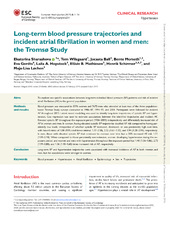| dc.contributor.author | Sharashova, Ekaterina | en_US |
| dc.contributor.author | Wilsgaard, Tom | en_US |
| dc.contributor.author | Ball, Jocasta | en_US |
| dc.contributor.author | Morseth, Bente | en_US |
| dc.contributor.author | Gerdts, Eva | en_US |
| dc.contributor.author | Hopstock, Laila Arnesdatter | en_US |
| dc.contributor.author | Mathiesen, Ellisiv B. | en_US |
| dc.contributor.author | Schirmer, Henrik | en_US |
| dc.contributor.author | Løchen, Maja-Lisa | en_US |
| dc.date.accessioned | 2020-08-12T09:00:16Z | |
| dc.date.available | 2020-08-12T09:00:16Z | |
| dc.date.issued | 2019 | |
| dc.Published | Sharashova EE, Wilsgaard T, Ball J, Morseth B, Gerdts E, Hopstock LA, Mathiesen EB, Schirmer H, Løchen M. Long-term blood pressure trajectories and incident atrial fibrillation in women and men: the Tromsø Study. European Heart Journal. 2019;41(16):1554–1562 | eng |
| dc.identifier.issn | 0195-668X | |
| dc.identifier.issn | 1522-9645 | |
| dc.identifier.uri | https://hdl.handle.net/1956/23675 | |
| dc.description.abstract | Aims: To explore sex-specific associations between long-term individual blood pressure (BP) patterns and risk of incident atrial fibrillation (AF) in the general population. Methods and results: Blood pressure was measured in 8376 women and 7670 men who attended at least two of the three population-based Tromsø Study surveys conducted in 1986–87, 1994–95, and 2001. Participants were followed for incident AF throughout 2013. Latent mixed modelling was used to identify long-term trajectories of systolic BP and hypertension. Cox regression was used to estimate associations between the identified trajectories and incident AF. Elevated systolic BP throughout the exposure period (1986–2001) independently and differentially increased risk of AF in women and men. In women, having elevated systolic BP trajectories doubled AF risk compared to having persistently low levels, irrespective of whether systolic BP increased, decreased, or was persistently high over time, with hazard ratios of 1.88 (95% confidence interval 1.37–2.58), 2.32 (1.61–3.35), and 1.94 (1.28–2.94), respectively. In men, those with elevated systolic BP that continued to increase over time had a 50% increased AF risk: 1.51 (1.09–2.10). When compared to those persistently normotensive, women developing hypertension during the exposure period, and women and men with hypertension throughout the exposure period had 1.40 (1.06–1.86), 2.75 (1.99–3.80), and 1.36 (1.10–1.68) times increased risk of AF, respectively. Conclusion: Long-term BP and hypertension trajectories were associated with increased incidence of AF in both women and men, but the associations were stronger in women. | en_US |
| dc.language.iso | eng | eng |
| dc.publisher | Oxford University Press | eng |
| dc.rights | Attribution-NonCommercial CC BY-NC | eng |
| dc.rights.uri | http://creativecommons.org/licenses/by-nc/4.0/ | eng |
| dc.title | Long-term blood pressure trajectories and incident atrial fibrillation in women and men: the Tromsø Study | en_US |
| dc.type | Peer reviewed | |
| dc.type | Journal article | |
| dc.date.updated | 2019-12-16T14:22:43Z | |
| dc.description.version | publishedVersion | en_US |
| dc.rights.holder | Copyright 2019 The Author(s) | |
| dc.identifier.doi | https://doi.org/10.1093/eurheartj/ehz234 | |
| dc.identifier.cristin | 1696231 | |
| dc.source.journal | European Heart Journal | |

